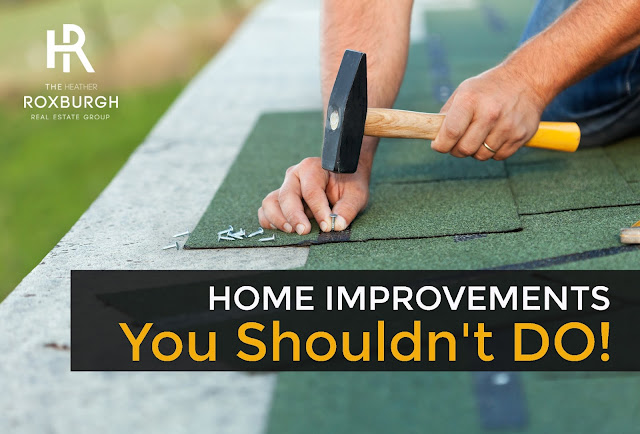3 Home Improvements You Shouldn't Make
Every homeowner who has contemplated a home improvement project has wondered how much the project would add to the value of their home.
It’s almost never a question of “Will it?” It’s always “How much?”
The good news is that according to the most recent Cost vs. Value report from Remodeling.com, most home improvement projects will add some value to your home. But—and this is an important but—your project probably won’t boost your home’s value enough to recoup the entire cost of the improvement. And in some cases, your upgrade may not add any value to your home at all!
We’ve categorized these home improvements in to four types:
⦁ Improvements to avoid if you plan to sell your home
⦁ Improvements to make if you plan to stay in your home
⦁ Improvements to make if you plan to sell your home
⦁ Invisible improvements
Improvements to Avoid if You Plan to Sell Your Home
The return on investment (ROI) on some projects is so low, you’ll be left holding the bag for about half the cost. That makes these especially poor choices for homeowners planning to sell.
⦁ Sunroom addition: Cost–$75,700, ROI–48%
⦁ Home office remodel: Cost–$29,000, ROI–48%
⦁ Bathroom addition: Cost–$40,000, ROI–57%
These improvements aren’t always bad choices. As we said before, if you’ll be living in your home a while and would enjoy a sunroom, extra bathroom or home office, go for it! But think twice (or a few more times) before you take on any of these projects solely for the purpose of increasing the sales value of your home.
Improvements to Make if You Plan to Stay in Your Home
In general, projects that add square-footage are best viewed as an investment in your family’s enjoyment of your home. At most, you can expect to recover just 64% of the cost of a family room, garage or second-story addition. Even less for sunrooms and bathrooms.
You’ll do a little better converting unused areas like your attic or basement in to living spaces. An attic bedroom will return 77% of its $51,000 price tag, and a $17,000 basement renovation will recoup 70 cents for every dollar you spend.
If you’re planning to stay in your home a few more years and need the extra space to keep family members from tripping over each other, by all means add the space! Your family will have plenty of time to appreciate the addition and, once you’re ready to sell, the boost in square footage will also boost your asking price.
Improvements to Make if You Plan to Sell
As we pointed out, large-scale projects don’t usually translate into large increases in your home’s value. So when you’re ready to sell, upgrades that make an impact for less money are the way to go.
For the last several years, simply replacing your front door with a new steel entry door has had the best ROI. According to the Cost vs. Value report, this is the one project that will pay for itself, returning nearly 102% of its $1,200 cost.
Other projects that improve your home’s curb appeal are also good bets:
⦁ Replace vinyl siding with manufactured stone veneer accents: Cost–$7,150, ROI–92%
⦁ Garage door replacement: Cost–$1,595, ROI–88%
⦁ Replace vinyl siding: Cost–$12,000, ROI–80%
⦁ Wood deck addition: Cost–$10,000, ROI–80%
Inside, a minor kitchen remodel will earn back 79% of its $19,000 cost. That includes replacing outdated appliances, re-facing the cabinets and adding new hardware, updating the laminate countertop and sink and replacing the flooring.
Invisible Improvements
You can drop a huge chunk of cash on home maintenance projects like replacing your heating and cooling unit, hot water heater or even your septic system. Unfortunately, even when these updates are brand new, most buyers aren’t willing to pay more for them. Buyers expect functional features like these to simply . . . function, and they don’t feel like they should pay for wear and tear that occurred in the home while you owned it.
On the other hand, if any of these invisible parts of your home aren’t in working order, it will detract big time from your home’s value. Even if you plan to sell soon, you can’t avoid these problems since they will certainly turn up in a home inspection. Go ahead and tackle the problems, just realize you’re maintaining your home’s value—not adding to it.
However, one update most homeowners would consider a maintenance project falls into a gray area of home improvement: a roof replacement. A new roof certainly isn’t a showpiece like a top-to-bottom kitchen renovation, but according to Remodeling.com, it can boost your home’s value. On average, homeowners nationwide can expect to recoup more than 70% of the $20,000 price tag of a mid-range roof replacement project.
Put Down That Hammer and Do Your Research
The tricky part to all of this is that we’re looking at national averages. Individual markets place different values on different home improvements. In San Francisco and Honolulu, for example, nearly every project had a 100%-plus return on investment.
The best way to gauge what you can expect in terms of resale value on home improvements—especially if you’re planning to sell soon—is to talk to a real estate agent who is an expert in your market. They’re sure to know the local trends, and they can show you how other homes with the features you want to add are selling. That way, you can make an educated decision before you start ordering lumber and knocking out walls.


Amazing work! You did a good job and it is worth-sharing. It will help and guide many readers and will continue following more of your articles.
ReplyDeleteInterior designers in chennai
Interior decorators in chennai
Home interior designers in chennai
Interior design companies in chennai
Modular kitchen chennai
Modular kitchen manufacturers in chennai